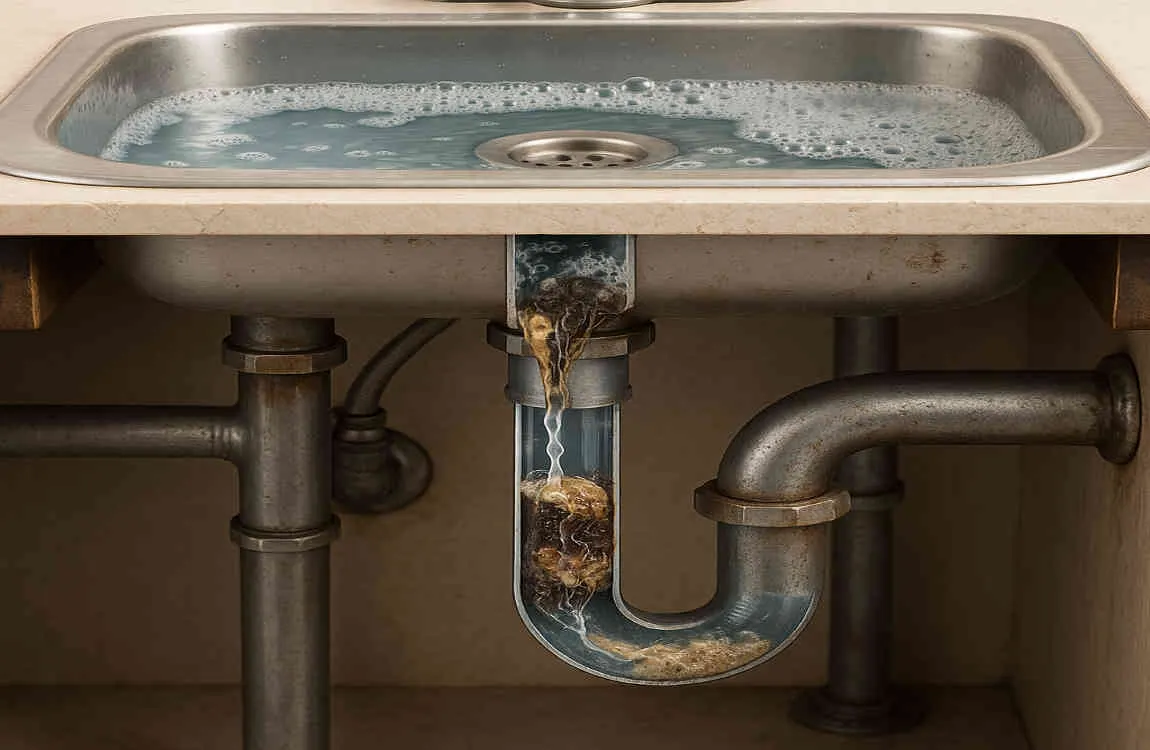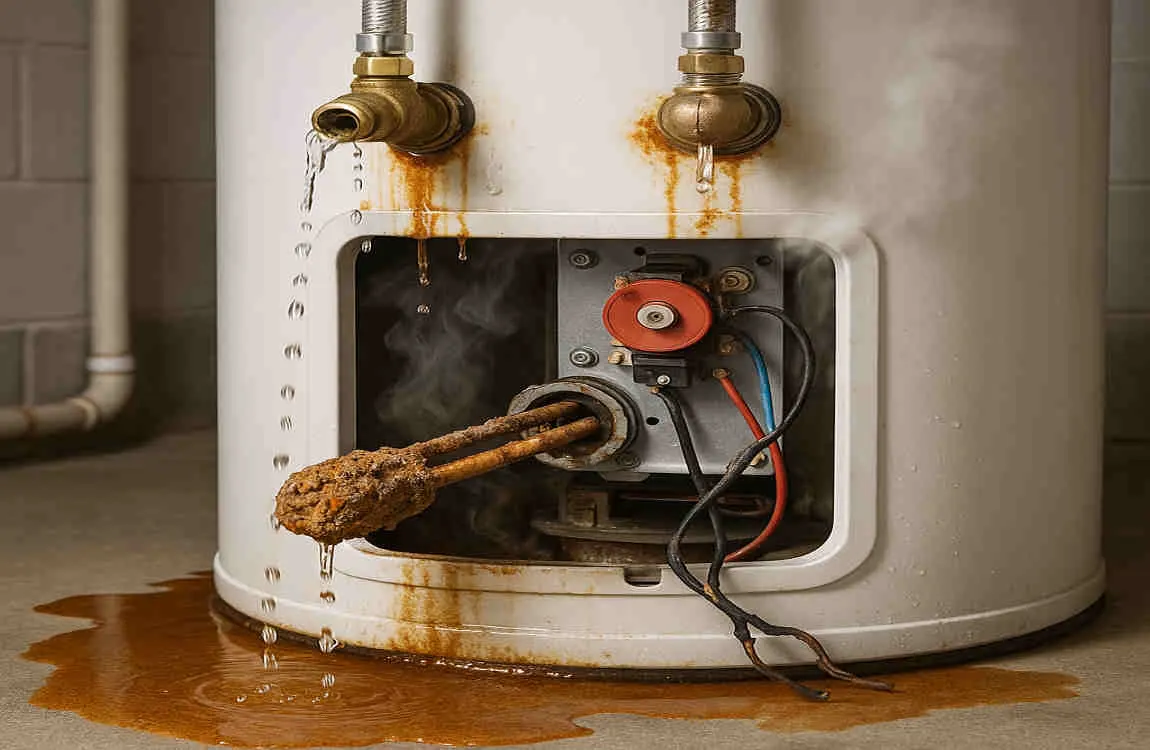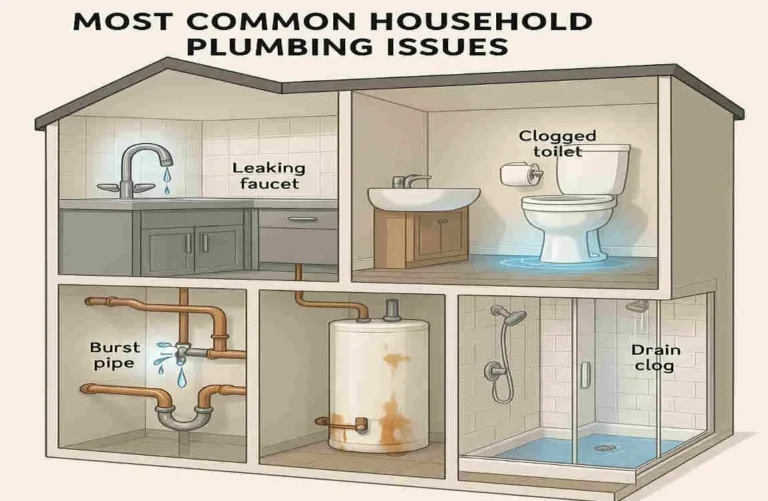Hey there, homeowner! Have you ever turned on the faucet and watched the water swirl slowly down the drain, or dealt with a surprise puddle under your sink? If so, you’re not alone. Household plumbing issues pop up in almost every home at some point, and understanding them can save you a ton of hassle and money.
Why bother learning about these everyday woes? Well, think about it: your home’s plumbing system is like the circulatory system of your house. It delivers clean water and whisks away waste without you even noticing—until something goes wrong. Ignoring minor issues can lead to big headaches, like flooded basements or skyrocketing water bills. Timely detection and maintenance aren’t just intelligent; they’re essential for keeping your home safe and efficient.
Slow-Draining Sink

Imagine washing dishes after dinner, and the water just sits there, refusing to budge. A slow-draining sink is one of the most frustrating household plumbing problems, but it’s also one of the easiest to understand and fix. It happens when things build up inside your pipes, slowing down the flow. Let’s break this down so you can handle it like a pro.
What Causes Slow Drainage?
Debris is often the main culprit. Think about all the hair, soap residue, and food scraps that go down your kitchen or bathroom sink every day. Over time, these bits stick together and form blockages. If you have hard water in your area, mineral deposits add to the mix, creating a stubborn layer inside the pipes.
Pipe design can play a role too. Older homes might have pipes with bends or narrow sections that trap gunk more easily. Temperature changes can also cause grease from cooking to solidify, turning a smooth drain into a sluggish one. Have you noticed your sink draining more slowly after washing greasy pans? That’s a classic sign.
How to Spot This Issue Early
Catching a slow drain early saves you from bigger messes. Listen for gurgling sounds as water goes down—that’s air bubbles struggling through a partial clog. If the water level rises before slowly dropping, pay attention. You might even smell a faint odour from trapped debris starting to rot.
Check multiple sinks in your home. If only one is slow, it’s likely a local issue. But if several are affected, it could point to a deeper problem in your primary household plumbing lines. Don’t wait until it’s a complete blockage; early action is key.
Simple DIY Fixes and When to Call a Plumber
You can often fix this yourself. Start with a plunger—create a seal and pump vigorously to dislodge the buildup. For a natural approach, pour boiling water down the drain, followed by a mix of baking soda and vinegar. Let it fizz for 15 minutes, then flush with hot water.
If that doesn’t work, try a drain snake—a flexible tool that reaches in and pulls out the gunk. But if you’ve tried these and the problem persists, it’s time for a professional. They have cameras to inspect pipes without tearing up your walls. Persistent slow drains might signal corroded pipes or tree roots invading your system.
Preventive Measures for Long-Term Health
Prevention is better than a cure, right? Make it a habit to clean your drains monthly. Use a hair catcher in bathroom sinks and avoid dumping grease down the kitchen sink. Instead, wipe pans with paper towels before washing.
Educate your family on proper disposal— no coffee grounds or eggshells in the sink! Installing a water softener can help with mineral buildup if hard water is an issue in your area. By staying proactive, you’ll keep your household plumbing flowing smoothly and avoid those annoying backups.
Clogged Bath or Shower Drains
Nothing ruins a relaxing shower like standing in ankle-deep water. Clogged bath or shower drains are a top complaint in household plumbing, often building up silently until they strike. These clogs disrupt your daily routine, but with some know-how, you can prevent and fix them.
You may also read (understanding the impact of polybutylene pipes on home sales).
Common Causes of These Clogs
Hair is the biggest offender here. It sheds during showers and tangles with soap scum to form a gooey mess. Add mineral deposits from hard water, and you’ve got a recipe for blockage. Over time, this buildup narrows the pipe, slowing water flow until it’s completely stopped.
Why does it happen gradually? Showers don’t have the same force as sinks, so debris accumulates without immediate notice. If you have long-haired family members or use oily hair products, the risk jumps up. Ever pulled a slimy hairball from your drain? That’s the culprit in action.
The Impact on Water Flow and Your Home
A clogged drain doesn’t just inconvenience you; it can lead to overflows that damage floors or walls. Stagnant water breeds bacteria, causing unpleasant smells and potential health issues. In extreme cases, it strains your entire household plumbing system, leading to backups in other areas.
Think about how it affects your day—rushed showers or skipped baths aren’t fun. Ignoring it can escalate to more serious problems, like pipe bursts from built-up pressure.
Effective Prevention Tips
Let’s keep those drains clear! Start with a drain cover—it catches hair before it goes down. Clean it weekly to stay on top. For periodic maintenance, try home remedies: mix baking soda and vinegar, pour it in, and follow with hot water after 30 minutes. It’s cheap and effective.
Use a plumbing snake monthly to snag any budding clogs. Avoid chemical drain cleaners—they can corrode pipes over time. Instead, focus on habits like brushing hair before showering. These small steps make a big difference in plumbing maintenance.
When to Get Professional Help
If DIY methods fail or clogs return frequently, call a plumber. They can use hydro-jetting to blast away deep buildup without chemicals. Professional inspection might reveal underlying issues like pipe corrosion or poor installation. Don’t hesitate—pros can save you from costly water damage.
Clogged Toilets
Ah, the dreaded clogged toilet—it’s embarrassing, messy, and all too common in household plumbing. One flush gone wrong can turn your bathroom into a disaster zone. But understanding why it happens and how to handle it can make all the difference.
Overview of Causes
Excessive toilet paper is a frequent cause; people often use more than needed, especially in households with kids. Then there are the no-nos: sanitary products, paper towels, or even toys flushed by curious toddlers. These items don’t break down like toilet paper does.
Foreign objects like wipes labelled “flushable” (spoiler: they’re not always) add to the trouble. In older homes, low-flow toilets might not have enough power to clear everything, leading to frequent jams.
Understanding Toilet Plumbing Design
Toilets work on a simple trap system—a curved pipe that holds water to block sewer gases. But this design makes it prone to clogs because the trap is narrow. If something bulky gets stuck, it blocks the flow entirely.
Modern toilets aim for water efficiency, but that can mean weaker flushes. Combine that with hard water deposits narrowing pipes, and you’ve got a setup ripe for issues. Ever wondered why some clogs happen after guests visit? Overuse can overwhelm the system.
Prevention Strategies
Educate everyone in your home: only flush pee, poo, and toilet paper—nothing else! Keep a small trash bin nearby for wipes and other items. For families, make it a fun lesson with signs or reminders.
Regularly check for slow flushes as an early warning. If your toilet gurgles or fills high before draining, act fast. Installing a higher-quality toilet paper that dissolves quickly can help, too.
Solutions for Minor Clogs and When to Call Pros
For minor clogs, grab a plunger. Use one with a flange for a better seal, and plunge with steady force. If that doesn’t work, try a toilet auger—it snakes through the trap to break up blockages.
Signs you need a pro? Repeated clogs, backups in other drains, or foul odours from the sewer may indicate issues. They might need to inspect for tree roots or damaged pipes. Don’t risk overflow—professional help prevents bigger messes in your household plumbing.
Water Leaks in Household Plumbing
Leaks might seem minor, but they can wreak havoc on your home and wallet. In household plumbing, water leaks are sneaky thieves, wasting water and causing hidden damage. Let’s uncover how they start and what you can do.
Common Sources of Leaks
Faucets are a prime spot—drips from worn seals add up fast. Toilets leak silently at the base or tank, while showers might seep from loose connections. Pipes under sinks or in walls can crack from age or pressure.
Don’t forget appliances like washing machines—their hoses can fail over time. In cold climates, frozen pipes burst when thawing, creating instant leaks.
How Leaks Develop
Deterioration is key; rubber washers wear out, and metal pipes corrode. Temperature swings expand and contract materials, weakening joints. Faulty installations or high water pressure accelerate the process.
Have you heard that dripping sound at night? It’s often residual pressure pushing water through tiny gaps. Ignoring it lets leaks grow, turning drips into floods.
Consequences of Ignoring Leaks
Leaks lead to mould growth in damp areas, damaging walls and floors. Water bills skyrocket— a single drip can waste thousands of gallons yearly. Structural issues like warped wood or foundation problems can follow.
Health risks arise, too, with mould causing allergies. It’s not just inconvenient; it’s expensive. Proactive fixes save you considerable time.
Early Detection Tips and Prompt Repair
Check under sinks for puddles or dampness. Monitor your water meter—if it moves when no water’s in use, there’s a leak. Listen for hissing sounds from pipes.
Tools like leak detectors attach to pipes and alert you via apps. For repairs, tighten fittings or replace washers yourself. But for hidden leaks, pros use infrared cameras.
Tools and Technologies for Detection
You may also read (how to safely turn off your home gas line).
Here’s a quick list of helpful tools:
- Moisture meters: Detect hidden dampness in walls.
- Acoustic detectors: Listen for leak sounds.
- Smart home sensors: Send phone alerts for unusual water use.
Investing in these keeps your household plumbing leak-free.
Faulty Water Heater Issues

Your water heater works hard behind the scenes, but when it falters, you’ll notice quickly—no hot showers are a big clue! Faulty water heaters are a common headache in household plumbing, affecting comfort and safety.
Signs of a Malfunctioning Water Heater
Inconsistent hot water is a red flag—sometimes scalding, other times lukewarm. Leaks around the base signal trouble, as do strange noises like rumbling or popping.
Discoloured water or a metallic taste points to internal rust. If your heater takes forever to recover after use, it’s struggling.
Causes Behind These Problems
Sediment buildup from minerals settles at the bottom, insulating the heating element and causing inefficiency. Thermostat failure leads to temperature swings, while corrosion eats away at the tank over the years.
Age is a factor—most last 8-12 years. Hard water speeds up wear, and poor installation can cause early issues.
Risks of Ignoring Water Heater Issues
A failing heater risks bursts, which can flood your home. Carbon monoxide leaks from gas models are dangerous. High energy bills pile up as it works harder.
Bacteria like Legionella can grow in inconsistent temperatures, posing health risks. Don’t wait—addressing issues early prevents emergencies.
Routine Maintenance Tips
Flush the tank annually to remove sediment. Check the anode rod every few years—it sacrifices itself to protect the tank from rust.
Test the pressure relief valve and insulate pipes for efficiency. Set the thermostat to 120°F to save energy and reduce scalding risks.
When to Repair or Replace
Repair if it’s a simple fix, like a new thermostat. But if leaks or rust are evident, replacement is smarter. Pros can assess and install energy-efficient models, improving your household plumbing long-term.
Low Water Pressure Problems
Low water pressure turns simple tasks like showering or filling a pot into frustrations. It’s a widespread issue in household plumbing, but it’s often fixable with some detective work.
Causes of Low Pressure
Mineral and sediment buildup clogs pipes, restricting flow. Partially closed valves in your home or main line can be culprits, too.
Faulty pressure regulators fail to maintain steady force, and leaks elsewhere steal pressure. In older homes, corroded pipes narrow over time.
How It Affects Functionality
Weak pressure means longer wait times for hot water and inefficient appliances. Dishwashers and washers don’t clean well, wasting time and water.
It can signal bigger problems like hidden leaks, affecting your whole system. Ever tried rinsing shampoo with a trickle? It’s no fun.
Troubleshooting Steps You Can Take
Start by checking aerators on faucets—unscrew and clean out debris. Inspect shut-off valves to ensure they’re fully open.
Test pressure at different outlets. If it’s low everywhere, call your utility company—it might be a municipal issue.
When to Seek Professional Services
If DIY checks fail, plumbers can measure pressure accurately and clear blockages with tools like hydro-jets. They fix regulators or repipe sections if needed. For low water pressure, pros ensure thorough solutions.
Dripping Faucets and Worn-Out Fixtures
That constant drip-drip from a faucet isn’t just annoying—it’s wasteful. Dripping faucets top the list of minor but nagging household plumbing issues, often from simple wear and tear.
Why Faucets Drip
Worn washers or O-rings lose their seal, letting water escape. Residual pressure in pipes pushes drips even after the water is turned off. Corrosion or loose parts add to it.
In hard water areas, minerals build up, forcing components to fail faster. It’s like a slow leak in your budget.
Impact on Water, Waste, and Bills
A single dripping faucet wastes up to 3,000 gallons yearly, hiking your bills. It contributes to global water shortages, too.
Over time, drips erode fixtures, leading to bigger repairs. Imagine the savings from fixing it early!
Simple Repair Tips
Turn off the water supply, disassemble the faucet, and replace the washer. It’s a 30-minute job with basic tools.
For cartridge faucets, swap the cartridge. Videos online guide you step by step.
When Replacement or Pros Are Needed
If repairs don’t hold or the fixture is outdated, replace it. Pros handle complex models, or if you spot leaks elsewhere. Keep your household plumbing efficient with timely fixes.
Sump Pump Failures
In flood-prone areas, a sump pump is your basement’s best friend. But when it fails, household plumbing disasters can follow, leading to water damage and costly cleanups.
Role of Sump Pumps in Flood Prevention
Sump pumps collect groundwater in a pit and pump it away, keeping basements dry. They’re crucial during heavy rains or snowmelt.
Without one working, water backs up, flooding floors and ruining belongings.
Common Causes of Failure
Electrical issues like power outages or tripped breakers stop them cold. Mechanical jams from debris or worn parts cause breakdowns.
Lack of maintenance lets sediment clog the system, reducing efficiency.
Effects on Household Plumbing and Property
Failures lead to mould, structural damage, and ruined possessions. It strains and can cause backups in your plumbing.
Insurance might not cover neglect-related floods, which can hit your wallet hard.
Preventive Maintenance and Backup Options
Test your pump monthly by pouring water into the pit. Clean the intake and check the float switch.
Install a battery backup for power outages. Schedule annual pro inspections for peace of mind in your household plumbing.
You may also read (household plumbing pipe sizes explained a quick overview).

